

The different shapes
With the passing years, shapes have
softened:
The first snuff boxes date back to the
second half of the XVIIth century. They were often pear-shaped. A
tiny hole at their top, enables, when shaking, to pour some powder on
the back of one's hand. These snuff boxes are called "secouettes"
(shakers).
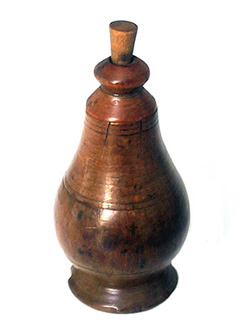 Example of a "secouette "
dated from the end of the XVIIth century, beginning of the
XVIIIth.
Plain under Louis XIV( "godrons",
"trophées"..) they softened under Louis XV to become
"rocaille", reminiscent of a scalop shell", oval, round, but more
often rectangular.
Example of a "secouette "
dated from the end of the XVIIth century, beginning of the
XVIIIth.
Plain under Louis XIV( "godrons",
"trophées"..) they softened under Louis XV to become
"rocaille", reminiscent of a scalop shell", oval, round, but more
often rectangular.
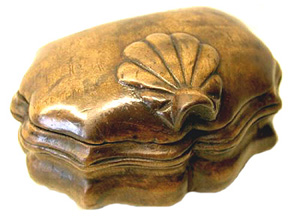 Walnut snuff box circa
1730
Around 1770, they tended to get oval or
in the shape of a shuttle.
Walnut snuff box circa
1730
Around 1770, they tended to get oval or
in the shape of a shuttle.
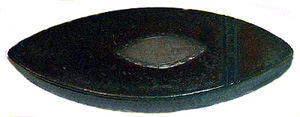 Shuttle shaped circa
1780
Finally, the end of the XVIIIth century
is a come back to plainess and classical style with motifs inspired
by ancient Greece (ovum, pilasters, interlacings...)
The decorations adapted to the evolution
of the styles : mythologic, romantic or hunting scenes, miniatures,
still lives, flowers....
Shuttle shaped circa
1780
Finally, the end of the XVIIIth century
is a come back to plainess and classical style with motifs inspired
by ancient Greece (ovum, pilasters, interlacings...)
The decorations adapted to the evolution
of the styles : mythologic, romantic or hunting scenes, miniatures,
still lives, flowers....
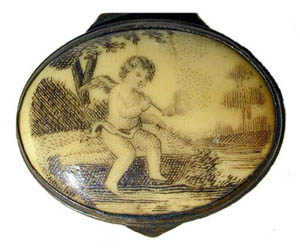 French snuff box / enamel /
1780
China snuff boxes were usually decorated
with Chinese scenes or"chinoiseries".
Caricatures as well as erotic scenes were
amongst the most common decorations: open to the eye and without any
ambiguity during the XVIIIth century, they were to be hidden in false
bottoms in the XIXth.
French snuff box / enamel /
1780
China snuff boxes were usually decorated
with Chinese scenes or"chinoiseries".
Caricatures as well as erotic scenes were
amongst the most common decorations: open to the eye and without any
ambiguity during the XVIIIth century, they were to be hidden in false
bottoms in the XIXth.
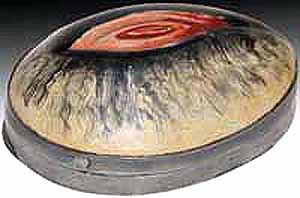 Erotic snuff box / pewter mounted
ceramic
Erotic snuff box / pewter mounted
ceramic
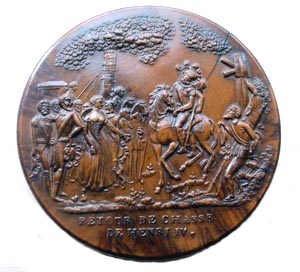 *
*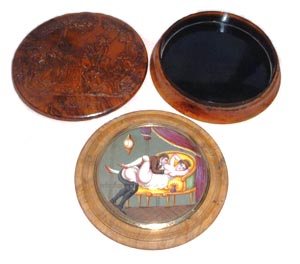
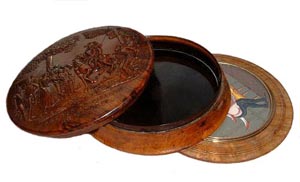 This rare French erotica
high quality snuff box
houses a secret compartment
containing an erotic picture of a
young couple. Circa 1820
The box itself measures 3 ¼
inches in diameter, and stands 7/8 inch high.
The title of the scene on the lid
is :
‘RETOUR DE CHASSE DE HENRI IV'
(The return of the hunt of Henry
4th)
Picture: Don
Preston Antiques, Leics/UK
This rare French erotica
high quality snuff box
houses a secret compartment
containing an erotic picture of a
young couple. Circa 1820
The box itself measures 3 ¼
inches in diameter, and stands 7/8 inch high.
The title of the scene on the lid
is :
‘RETOUR DE CHASSE DE HENRI IV'
(The return of the hunt of Henry
4th)
Picture: Don
Preston Antiques, Leics/UK
The most common material used:
At the beginning of the XIXth century,
Napoleon I' s ardent supporters adopt pocket snuff boxes made of
black horn, brass or wood bearing the effigy of their idol, in the
shape of his hat, or glorifying his victorious battles.
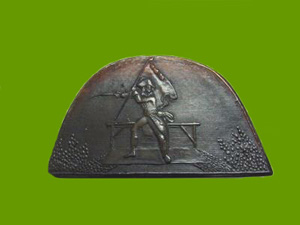 *
*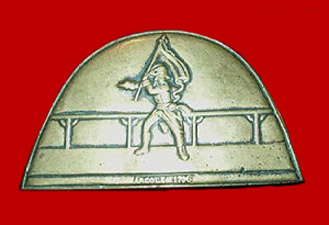 Snuff box shaped as Napoleon's
cocked hat made of dark horn and other one in brass
Snuff box shaped as Napoleon's
cocked hat made of dark horn and other one in brass
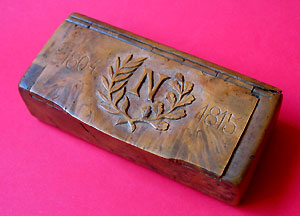 1*
1*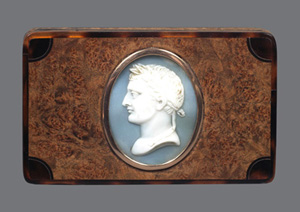 2
Pictures: 1:
www.tabacollector.com; 2: www.desouzy.com
Snuff box made of box wood and
other one made of thuja and tortoise shell with a cameo
2
Pictures: 1:
www.tabacollector.com; 2: www.desouzy.com
Snuff box made of box wood and
other one made of thuja and tortoise shell with a cameo
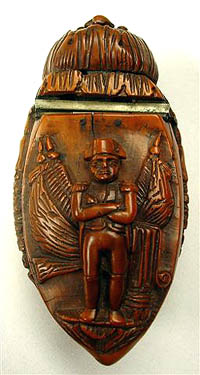 *
*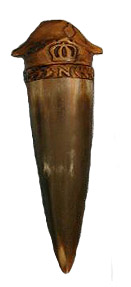 Snuff boxes made of coco
nut and other one in horn
Snuff boxes made of coco
nut and other one in horn
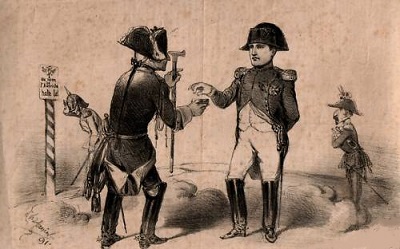 Lithography showing
Napoléon taking a pinch of snuff
Conversely, those who looked back
nostagically to the monarchy carry models made of papier maché
representing a weeping willow or profiles of Louis XVI,
Marie-Antoinette or the dauphin:
Lithography showing
Napoléon taking a pinch of snuff
Conversely, those who looked back
nostagically to the monarchy carry models made of papier maché
representing a weeping willow or profiles of Louis XVI,
Marie-Antoinette or the dauphin:
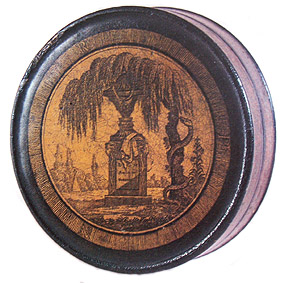 Picture: book:
Tabac et Sociétés "l'herbe de tous les maux"
Musée du
tabac BERGERAC
During the restoration period (1815-1830)
and Charles the X (1824-1830), pocket snuff boxes were more often
made of burr wood, using rounded shapes and ornamented with portraits
or scenes with pastel colours inspired by the romanticism.
Snuff boxes with mottos or with
interlaced initials were very popular too.
Picture: book:
Tabac et Sociétés "l'herbe de tous les maux"
Musée du
tabac BERGERAC
During the restoration period (1815-1830)
and Charles the X (1824-1830), pocket snuff boxes were more often
made of burr wood, using rounded shapes and ornamented with portraits
or scenes with pastel colours inspired by the romanticism.
Snuff boxes with mottos or with
interlaced initials were very popular too.
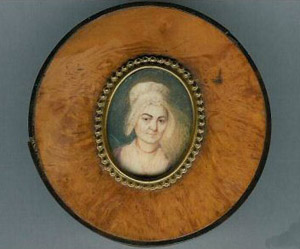 burr snuff box with
miniature
From Louis Philippe (1830), the current
taste is pastiche. Compared with the decorations of previous
centuries, we find naive scenes, often personalized by a name , a
date or a tool. Countryside scenes, works in the fields, saucy motifs
and carictures were to be fore.
burr snuff box with
miniature
From Louis Philippe (1830), the current
taste is pastiche. Compared with the decorations of previous
centuries, we find naive scenes, often personalized by a name , a
date or a tool. Countryside scenes, works in the fields, saucy motifs
and carictures were to be fore.
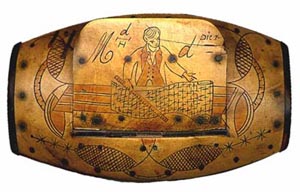 *
* Draper and cartwright' s
snuff boxes
The most common snuff boxes were made of
exotic woods (gaïac, amourette or ebony), laminated thuja,
boxwood and burr (cherrywood). We also find some made in bovine or
corded stag horn, in engraved bones (walrus ivory, sperm whale
teeth...), in metal rimmed shells or in corozo nutshell (also called
"vegetal ivory").
Draper and cartwright' s
snuff boxes
The most common snuff boxes were made of
exotic woods (gaïac, amourette or ebony), laminated thuja,
boxwood and burr (cherrywood). We also find some made in bovine or
corded stag horn, in engraved bones (walrus ivory, sperm whale
teeth...), in metal rimmed shells or in corozo nutshell (also called
"vegetal ivory").
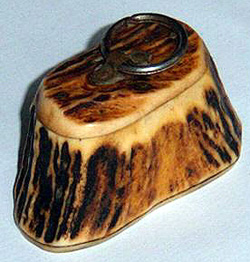 *
*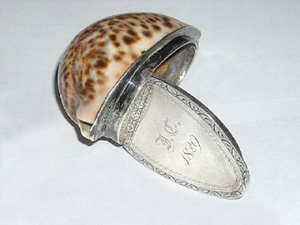 Snuff boxes made of stag horn and
other one in Cowrie shell + silver
Snuff boxes made of stag horn and
other one in Cowrie shell + silver
 Corozo nutshell
In addition to all these materials, we
can also add : straw marquetry, boiled cardboard, papier
mâché, blonde or black horn with or without ivory
inlays, tortoise shell, stoneware and pewter not forgetting copper
and brass.
Corozo nutshell
In addition to all these materials, we
can also add : straw marquetry, boiled cardboard, papier
mâché, blonde or black horn with or without ivory
inlays, tortoise shell, stoneware and pewter not forgetting copper
and brass.
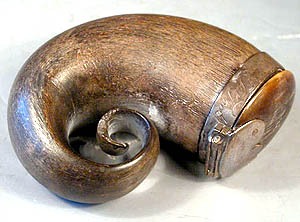 Beautiful example of a Scottish
"Mull" made from horn with silver inlay
Black lacquer only appears during the
second Empire ( 1852-1870) and at the end of the XIXth century,
boiled leather and carved coconuts were highly rated.
Beautiful example of a Scottish
"Mull" made from horn with silver inlay
Black lacquer only appears during the
second Empire ( 1852-1870) and at the end of the XIXth century,
boiled leather and carved coconuts were highly rated.









 *
*
 1*
1* 2
2 *
*

 *
*
